PROJECT EIGHT:
Did you enjoy inventing constructed surfaces? – Yes, like a young child playing with Tic Tac Toe on an Apple tablet for the first time.
Were you surprised at the results? – Only those that didn’t end up as I had expected. Because I have had some contact in the past with working with odd materials all surprises were happy ones.
Can you see a connection between your choice of materials and the type of structures you made – regular, irregular, small or large-scale? Having been involved in the Carpet manufacturing industry I had an immediate affinity with the weaving of Axminster and Wilton carpets (loop and cut pile). On a larger scale, my designs and the designs created in the design room had immediate impact because of the 12′ wide runs and complexity of patterns.
Which sample worked best? – simple repetitive designs and less than complex mixes of materials.
How accurate were you in matching all the colours in your image? – Compromise was an integral ingredient with paints and yarns/fibres so long as the shades and tones were complimentary.
PROJECT NINE:
Did you have enough variety in your collection of yarns and other materials? – No. Obviously I am going to have to search out more suppliers fora greater variety of yarns and fibres for more developed outcomes but for the work that I have just set out on I had sufficient to get a good idea of where the pieces are heading should I continue to work in this medium.
Which kinds of yarns, etc., did you use most? – Knitting and sock making yarns.
How do their characteristics affect the look and feel of each sample? – Much more condensed and compressed. More precise and complete in the detail of the design and smoother in their texture and softness to touch.
How did you find weaving in comparison to the other techniques you’ve tried? – Much slower and demanding but more satisfying in that the wool and fibre textures had a sense of excitement as the pattern started to evolve. I can’t wait to get my own computer loom and acquire newer synthetic and non standard materials to work with.
How do you feel about your finished samples? – Because I worked as ‘weave as you go samples’ rather than from my own designs, let down and disappointed in the outcomes. I need to be more resolved in my work. I will have to check but the size of my weaving frame may have been larger than the one I was asked to work on. I possibly should have been working on a smaller frame and completed more samples.
Are you happy with the relationship of the textures, proportions, colour and pattern to the finished size? – Only partially. Needs a lot more experimenting and working of other samples than I had the time available. I did succeed with plating, combining and making non weaving objects. Was successful at using the Soumak weaving technique. Could try a lot more of these variations.
Is there any part you would want to change? – Yes I would want to change to more efficient tools of the trade rather than feeding the shuttle by hand and using cardboard for substitute bobbins. Also paper clips were not the best way to raise and lower the warp threads. Studying the basic techniques of weaving under supervision or at a workshop will help solve some of these problems.
How would you tackle this process differently another time? – Spend time studying and practicing how to join together lines of weft threads when the colours, types of yarn/fibre or contours change.
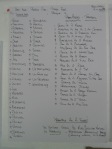


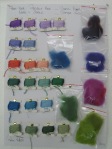
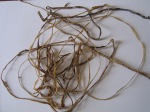
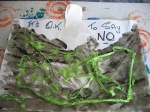
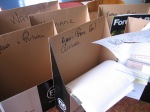

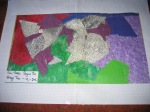

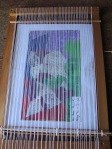
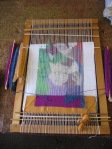
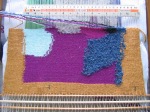
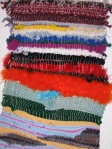
You must be logged in to post a comment.